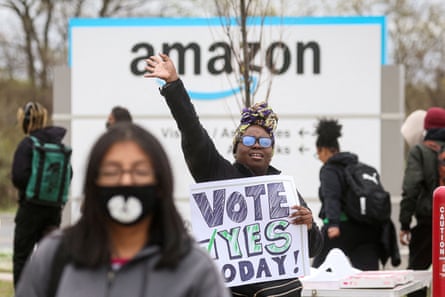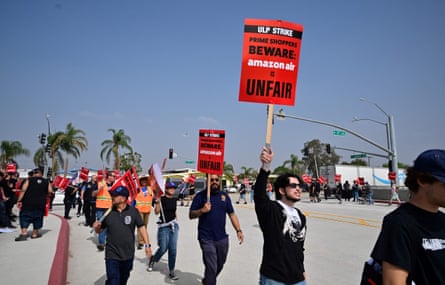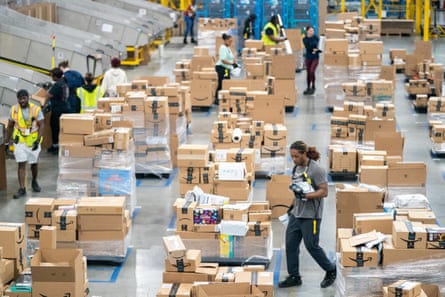
A year ago, Amazon workers in Staten Island, New York won a “historic” victory – overcoming a multimillion-dollar campaign by the multibillion-dollar corporation to win the right to organize Amazon’s first-ever union.
A year on from that victory – which labor leaders had hoped would trigger a wave of union victories – is looking less momentous and another union election win at Amazon has remained elusive.
The company has continued to aggressively oppose unionization and organizing efforts at its warehouses. Critics charge US laws and issues at the National Labor Relations Board (NLRB), the federal agency charged with enforcing US labor law, have stymied progress for the new labor movement.
And in the meantime, the Amazon Labor Union (ALU) has suffered from internal strife and disagreements over future strategies and tactics. The Staten Island win made a star of the ALU president, Chris Smalls, who Amazon’s management had personally denigrated. Since then several union leaders have resigned in protest over Smalls’ focus on traveling and public appearances and raised concerns that rushing union elections at other sites had come at the cost of focusing on the first union contract fight at JFK8.
Even the victory at the JFK8 warehouse in Staten Island still faces issues. Amazon appealed and delayed accepting the election results at JFK8, and has yet to begin bargaining with the Amazon Labor Union.
In the last year, Amazon has opposed and fought subsequent union elections and union organizing campaigns at other sites and continues to fight charges of unfair labor practices filed by workers involved in these campaigns. Charges have ranged from worker firings to workplace access for workers organizing.
The company spent over $14.2m on anti-union consultants in 2022.
“It’s a very stark demonstration of all the flaws in the National Labor Relations Board process and how the current law really plays into the hands of the anti-union employers,” said Rebecca Givan, a professor of labor studies and employment relations at Rutgers University, on the long delays in resolving NLRB charges and getting Amazon to the bargaining table since the union election win.
“It demonstrates the objectives of the National Labor Relations Act are so far from being fulfilled, and to really rebound, labor law reform is needed,” Givan added. “The fact employers can spend an unlimited amount to fight organizing and hide a great deal of that spending, the fact that workers who are organizing have no right to equal time, and the fact that employers can use every trick imaginable to delay, delay, delay and try to win a war of attrition. It demonstrates all of the holes in current labor law.”
So far, no Amazon union campaign has come close to replicating the Staten Island victory. ALU came up short in union elections in Albany, New York, at another warehouse in Staten Island, and pulled a union election petition shortly after filing in California, though the union is currently supporting a union campaign in Kentucky and at Amazon’s air hub outside Cincinnati, Ohio.
Cause, another independent union organizing effort, has been pushing to organize workers at Amazon in the Fayetteville, North Carolina, area since January 2022.
The Retail, Wholesale and Department Store Union came up short in the rerun of a union election in March 2022 at an Amazon warehouse in Bessemer, Alabama, after the NLRB ordered a new election due to Amazon’s misconduct during the first election. The second election results have yet to be finalized. Unfair labor practice charges are still being adjudicated and objections to the elections, which include 400 contested ballots that could sway the result, are yet to be decided.
In the meantime, efforts to pass sweeping labor law reforms in Congress have stalled. The House passed the Joe Biden-backed pro-union Pro Act in 2021, but the bill did not reach a Senate vote. Reintroduced in the House and Senate this year, the act now faces a House under Republican control that is unlikely to vote in its favor.
With unionization efforts stalled, organizing at Amazon has extended beyond the goal of formally winning union elections.
The Athena Coalition, consisting of numerous worker centers and non-profits, has focused on supporting workers at Amazon and their efforts in garnering support for petitions and organizing walkouts supporting concrete demands at Amazon sites in Georgia, California, Illinois, Minnesota and elsewhere.
The differing organizing avenues share similar goals; improving the grueling working conditions at Amazon, from addressing high injury rates and poor treatment of injured workers, constant surveillance of workers and productivity pressures, the lack of job security and high turnover at Amazon sites, issues with adequate bathroom breaks, to lagging pay rates.
Anna Ortega has worked at Amazon’s KSBD air hub in San Bernardino, California, since June 2021. Initially, she declined to get involved in organizing efforts with Inland Empire Amazon Workers United at the site in late 2021 but decided to do so after seeing the impact of a petition effort on compensating workers for site closures.

Since then, a group of workers at the site has petitioned, rallied and organized walkouts for improved heat protections for workers who work outside on the air ramps, improved policies for how injured workers are treated, and a $5-an-hour wage increase.
“We’re fighting to be able to work with respect and to be treated like a human being and not like a little robot,” said Ortega.
Jennifer Crane started working at Amazon at STL8 outside of St Louis, Missouri, as a packer in July 2021. A single mother with seven kids, two of whom also work at the same Amazon warehouse, said she had seen numerous injuries and been injured on the job while trying to keep up with productivity demands at the warehouse.
“They need to lower our rate of work and give us a few more breaks, we need better accommodations for those who have injuries, and treat your employees like they actually care, because right now I don’t feel like they care, they’re more worried about getting as many boxes as they can,” said Crane. “Amazon’s designed to give customers their packages fast. They don’t care about their employees.”
She participated in a one-day walkout in November 2022 as part of a “Make Amazon Pay” campaign to highlight working conditions and lagging wages at Amazon.
Workers have also organized walkouts and petitions over health, safety and economic concerns at Amazon warehouses in Georgia, Minnesota and Illinois.
In Joliet, Illinois, the worker center Warehouse Workers for Justice, has been organizing and supporting workers at the MDW2 Amazon warehouse.
“Workers still have concerns about the way that the company is addressing health and safety,” said Tommy Carden, an organizer at Warehouse Workers for Justice. “Amazon needs to start treating them with more respect, paying them better, and giving them a healthier and safer workplace.”
Workers at the site have held walkouts and protests over racism at the site and to demand overtime compensation and better pay.
“They want to be able to be paid fairly for their work, that means getting $25 an hour, a living wage,” said Maria Alfaro, organizing director at Warehouse Workers for Justice . “They say despite Amazon relying on us, we’re still invisible because we have low pay, unsafe work conditions and little job stability and so they want to see that change.”

In Georgia, workers engaged in similar walkouts and protests in late 2022, and filed several unfair labor practice charges with the National Labor Relations Board.
“Amazon, it’s one of the companies that really talks about a big game about how good they treat their workers, and yet, when you actually talk to workers, it’s the total opposite,” said Aliss Lugo, an organizer with United for Respect at Amazon, who has been organizing Amazon workers in Georgia where workers have held walkouts and submitted petitions over working conditions and policies such as security issues in parking lots to better bathroom access.
“It’s very difficult, but we’re still doing it because I think it just shows how fed up and tired workers are of the situation at work,” added Lugo. “They’re looking for ways to bring their demands to the front, to put pressure on the company, from meeting with shareholders, talking to the press and elected officials, and to raise awareness. This really needs to be a community effort to uplift these workers and bring the issues that they’re speaking about forward in any way possible outside of a traditional union election process.”



